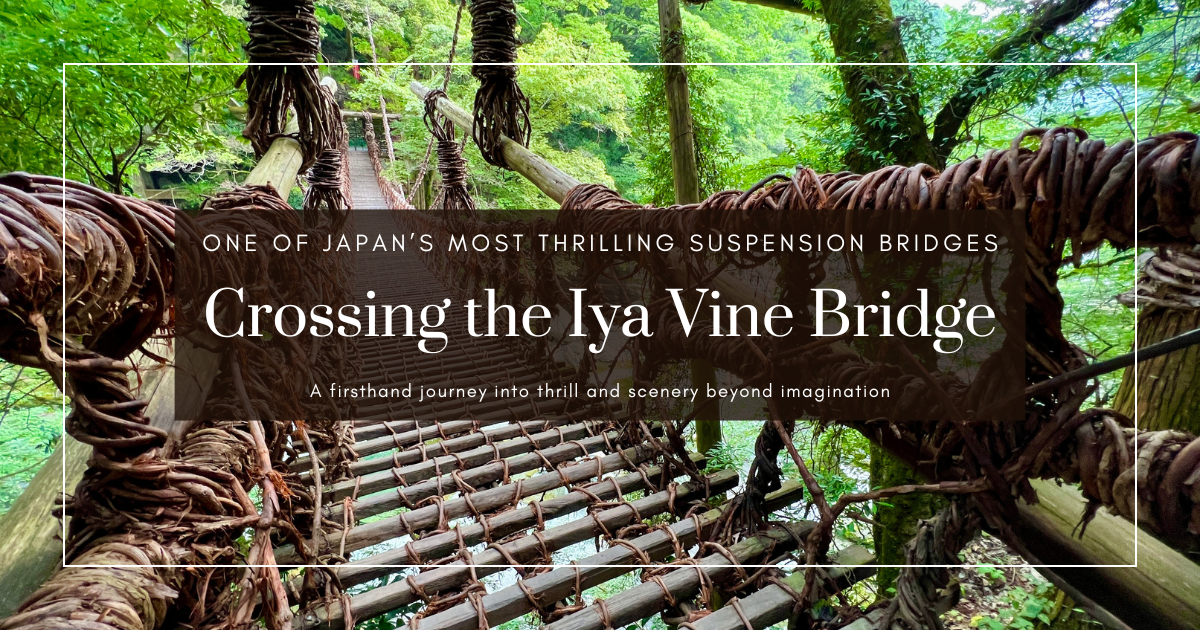
- Iya Vine Bridge Travel Guide 2025: Thrills, Views, and Legends in Tokushima's Remote Valley
- Experience the Iya Vine Bridge in Tokushima—where dramatic landscapes, thrilling steps, and centuries-old legends come together in Japan’s remote valley.
Last updated:

Nestled deep in the mountains of Miyoshi City, Tokushima Prefecture, Iya Valley is known as one of Japan’s top three most remote regions.
Spanning this dramatic landscape is the Iya Vine Bridge, counted among Japan’s “Three Unusual Bridges” for its unique structure and history.
The most compelling part isn’t just its striking appearance—it’s the intense thrill of actually walking across it.
In this article, I’ll share my firsthand experience crossing the bridge, along with plenty of photos to help you feel the journey.
For more details about the Iya Vine Bridge, see the article below:
Read more about Iya Vine Bridge
Let me start by saying—crossing the Iya Vine Bridge is a serious thrill.
I’m not scared of roller coasters or haunted houses, but this bridge genuinely frightened me.
There’s no way I could walk across while holding my phone. If I dropped it, it would fall straight into the Iya River below—gone forever.
And the bridge sways.
While kids crossed laughing and having fun, most adults were clearly nervous.
Hopefully, this report helps you imagine what it’s like.
Despite being in a remote area, parking is well-organized near the bridge.
The largest lot is the city-run Kazurabashi Yumebutai Parking, which has 350 spaces. Parking costs 500 yen for cars and 210 yen for motorcycles.

Across the road, there’s a privately-run gravel lot that charges 300 yen—a bit cheaper than the municipal lot.



The private lot uses a payment box system with no change provided, so bring 100-yen coins. It also accepts QR code payments (PayPay, LINE Pay, au Pay, Rakuten Pay), which is a convenient, cashless option.


After parking, you’ll walk downhill.


There’s no sidewalk, so be careful if you have children with you.
Along the way, you’ll pass a restaurant called Yamasato.


It was too early on this visit so the shop was closed, but it serves Iya soba, skewered “dekomawashi,” and grilled river fish like sweetfish and amego. It’s a popular place. Since the return route uses the same path, you can stop by afterward.
After Yamasato, continue walking downhill.

At the bottom of the hill, you’ll reach the Iya Gorge Bridge. Cross here.

This bridge has a pedestrian walkway, so it’s safe to cross.

From the center, you can spot the Iya Vine Bridge below.

With the river flowing below and greenery all around, the view is breathtaking.
Although it’s just a 4-minute walk from the parking lot, you’ll want to budget about 10 minutes to enjoy the view here.

After crossing the Iya Gorge Bridge, you’ll find a path leading down toward the vine bridge.

The trail has some ups and downs but is well-maintained.


It feels refreshing to walk through this forest path.


As you continue, you’ll reach the ticket booth.


And here it is—the Iya Vine Bridge.


Before crossing, you’ll need to buy a ticket. Payment can be made with cash or PayPay QR code.
Take a look. The Iya Vine Bridge up close is stunning and intimidating.

It looks like something out of an Indiana Jones movie.



The bridge is anchored to massive trees. Even before you set foot on it, the thrill begins.

Here comes the real challenge.
Look down—there are wide gaps in the planks.

The gaps are about 15 cm apart. You won’t fall through, but your foot could easily slip. Every step takes nerve.

Because of this, sandals are a bad idea.
If your sandal slips off, it’s guaranteed to fall into the river.
That said, someone ahead of me was wearing sandals. I was nervous just watching them.

Here’s a reassuring fact.
The vine bridge is rebuilt every three years. So don’t worry—it won’t collapse from age.
Also, the bridge is reinforced with steel wire, ensuring safety.
But your phone? That will fall. If you plan to take photos or videos while crossing, make sure to use a strap or take precautions so you don’t drop it.

The Iya Vine Bridge isn’t just thrilling—it’s also stunning.
Its delicate structure made from hardy vines looks like a work of art, beautifully contrasting with the surrounding greenery.





The Iya Vine Bridge offers not only thrills but a chance to witness the harmony of tradition and nature.
At the end of the bridge is a paved road.

Turn right to see Biwa Waterfall, or left to return to the Iya Gorge Bridge.
There’s a restroom nearby too.

Now you’re back at the Iya Gorge Bridge.

From here, you’ll walk uphill to return to the parking lot.


The Iya Vine Bridge is both a cultural marvel and a physical challenge—one of Japan’s Three Unusual Bridges in one of its most secluded valleys.
Though the thrill was intense, the bridge’s structure felt safe, and its natural beauty was unforgettable.
Plan for at least an hour to cross the bridge and explore, plus extra time for food, rest, or shopping.
In the mountains of Tokushima, the contrast of forest, timber, and the Iya River below creates a scene that will stay with you.
I highly recommend the Iya Vine Bridge. Visit if you get the chance.
